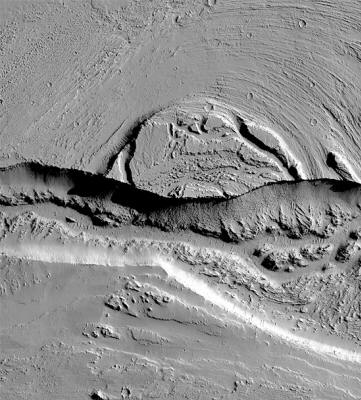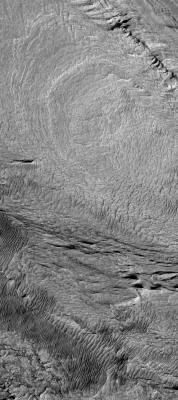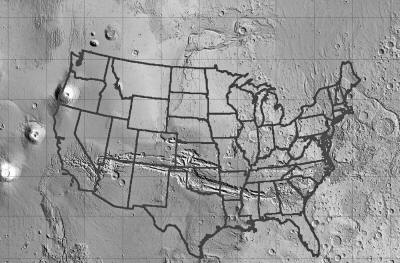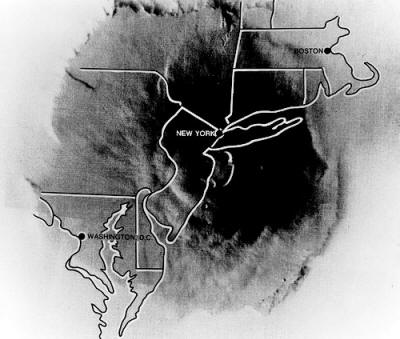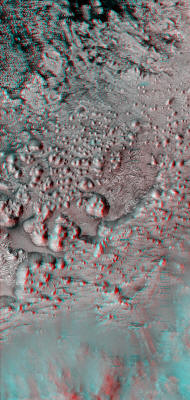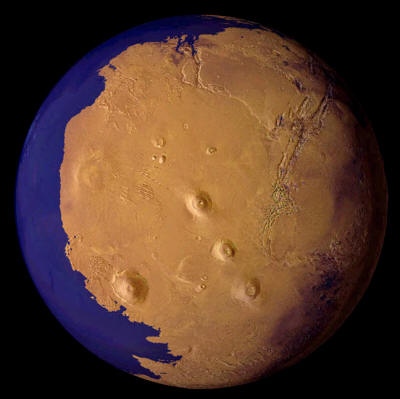|
So-called "flood channel."
Olympia Fossae in the
Martian Tharsis region.
Scientists from the University of California reported in June 2007 that a “confirmation” for the Martian liquid ocean theory was found: “shorelines” extending for thousands of kilometers around a large lake that existed a little over three billion years ago.
It is speculated that the "liquid
oceans" have been gone for over two billion years.
The
flowing water hypothesis continues to guide consensus theories,
however.
Instead,
lava flows are thought to play a more significant role than
previously considered.
The prevailing view of Mars is that it is covered with a layer of ice.
The soil temperature has been measured
to be about minus 50° Celsius; so cold that carbon dioxide freezes
solid. If water exists, it has to be locked in icy soils or in
underground vaults, since the low-density atmosphere would cause
water-ice out in the open to sublime to its vapor phase.
The soil around Phoenix was
nonconductive, indicating no water. Phoenix froze to death when it
was encased by almost 3 meters of frozen carbon dioxide during the
Martian winter, so it is probable that it was dry ice providing the
visual clue rather than water-ice.
Many images (below image) taken by the Mars Reconnaissance
Orbiter (MRO) indicate that Mars was once the scene of devastating
plasma discharges that, among other effects, ripped out the northern
terrain to a depth of six kilometers below the planet's mean
elevation.
Burned craters and piles (below image) of scorched dust lead to the conclusion that lightning thousands or millions of times more energetic than we know today resurfaced Mars.
The existence of these formations constitutes a confirmation of the Electric Universe hypothesis.
Valles Marineris, Olympus Mons, the
terraced mounds in Arabia Terra, as well as both Martian poles
demonstrate strong support for the electric discharge theory. Valles Marineris
Olympus Mons
terraced mounds - Arabia Terra
It is possible that there are ice deposits on Mars formed during the catastrophic events that altered its surface.
The aforementioned
plasma discharges left behind sinuous rilles, flat-floored craters,
"railroad track" patterns in canyons, intersecting gullies, and
giant mesas (below image) with Lichtenberg "whiskers."
Lightning of sufficient power can compress material in the discharge channel and accelerate it along with the negative charge, forming a jet.
If the jet contains water vapor, liquid water or even ice might
form inside the spinning
Birkeland filament due to z-pinch effects.
If this phenomenon were to be scaled up to planetary dimensions, the
increased electric discharges might have dumped quantities of ice
particles onto the surface that clumped together into the frozen
piles of debris that MRO's imagers allegedly detected.
If what we find on Mars took place in the presence of planetary lightning bolts and was not the result of ice or water moving across the surface, should we rethink our ideas about similar observations here on Earth?
Mars Had Large Oceans from Space Website
with an ocean
filling the lowland basin that now occupies the north polar region. Since 1991, planetary scientists have floated the idea that Mars once harbored vast oceans that covered roughly one-third of the planet.
Two long shore-like lips of rock in the
planet's northern hemisphere were thought to be the best evidence,
but experts argued that they were too "hilly" to describe the smooth
edges of ancient oceans.
The warping of the Martian rock has hidden clear evidence of the oceans, which in any case have been gone for at least 2 billion years.
Twin shores
Somewhere along the way to toppling over 50 degrees to the north, Mars probably lost some of its water, leaving the Deuteronilus Ocean's shoreline exposed.
The remaining sea would have been
located in the same lowland plain as the Arabia Ocean, but almost 40
degrees to the north.
The volcanic Tharsis region of Mars, a vast raised area along Mars' equator, is evidence for how this works.
Perron and his team reasoned that the oceanic shorelines were once near the equator, but warped into hilly up-and-down elevations of rock as they move towards the north with the tilting planet.
By calculating the deformation, which occurs in a predictable way, the planetary research team found the ridges had to have once been flat, like ocean shorelines.
Perron and his colleagues aren't certain what caused the toppling of the planet, but they think forces beneath the surface are to blame.
|

